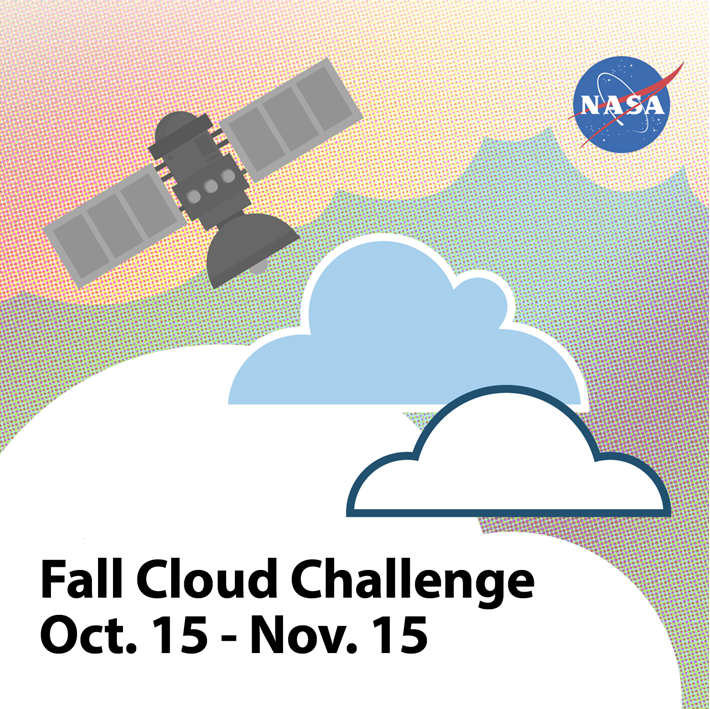Who knew that being a scientist could be as easy as pointing your phone at the sky? This month, NASA and the GLOBE Program are asking citizen scientists to take out their phones and report what kinds of clouds they see above them.

From October 15 to November 15 citizen scientists young, old, and in-between can submit up to ten cloud observations per day using the GLOBE Observer app or one of GLOBE’s other data entry options (for trained members). Participants with the most observations will receive a personalized thank you from a NASA scientist.
“What excites researchers about GLOBE observations is the ability to see what’s up in the sky from volunteers’ perspectives all over the world,” said Marilé Colón Robles, lead for the GLOBE Clouds Team at NASA’s Langley Research Center. “What our eyes can see is difficult to fully duplicate with instruments. Merging these views is what makes a complete and impactful story.”
“We want to do a data challenge in the fall and see if there are any differences from what was observed during the spring data challenge of 2018,” said Colón Robles. “From thin, high clouds that are hard for satellites to detect to dust storms that impact our daily lives, these observations play an important role in better understanding our atmosphere.”
At NASA, scientists work with a suite of satellite instruments known as the Clouds and the Earth’s Radiant Energy System (CERES). Though they have these highly sensitive instruments, it can sometimes be difficult for scientists to distinguish features such as cirrus clouds from snow cover in their imagery because both are cold and bright from a satellite perspective. By comparing satellite images from a particular area with data submitted by citizen scientists, researchers can differentiate between the two.
Lucky GLOBE observers might make an observation while the Cloud-Aerosol Lidar and Infrared Pathfinder Satellite Observation (CALIPSO) is overhead. CALIPSO is a joint mission between NASA and the French space agency (CNES) that uses laser pulses to measure clouds and atmospheric aerosols. Citizen scientists who make observations at the same time and place as CALIPSO will receive an emailed satellite comparison of CALIPSO’s measurements showing features such as high clouds, dust, and smoke. Scientists are especially interested in these observations in order to improve their understanding of dust storms. During the challenge, make sure you turn on daily satellite notifications in the app or use this satellite overpass website to see the schedule for your location.
“Last year’s challenge gave researchers special glimpses into cloud types around the world,” said Colón Robles. “Photographs provided by observers gave insight into events such as dust storms and wildfires. Our hope is to once again learn from the community and together study our atmosphere.”
The 2018 data challenge, which took place in the spring, received more than 56,000 cloud observations from more than 15,000 locations in 99 countries and Antarctica.
NASA is a sponsor of GLOBE, an international science and education program that provides students and the public with the opportunity to participate in data collection and the scientific process. NASA GLOBE Observer is a free smartphone app that lets anyone make citizen science observations from the palm of their hand.
Cloud Identification Resources and Tips
- Educators: Use this recommended activity outline perfect for the classroom or afterschool settings
- GLOBE Cloud Identification Chart (English)
- GLOBE Clouds Window Viewer
- Dr. Lin Chamber’s tip for cloud observers
- Dr. Tina Cartwright’s foldable dichotomous key for cloud identification
Data collection and data entry help
- Cloud Data Sheet (print form) – You can use this form to gather data. Please remember that you need to enter the data into GLOBE or GLOBE Observer to be considered for the data challenge.
- Tips and tricks for using the GLOBE Observer app for cloud observations
- GLOBE Web Tutorials on how to use the GLOBE website
Tags: citizen science, clouds, GLOBE, observation




Hi nasa
Am Surveor Mohamed Almahadi from Sudan, and very interested to be part of this challenge, I have a good experience on maps and using survey applications, so hope to one of your effective volunteers.
Thanks regard
Hello NASA,
Wish to enrolled in this data collection project.
Best wishes
Shibu Kallingal
Looking forward to it but will need good instructions
I look forward to answering this challenge, love the different cloud formations and would love to participate.
Dear NASA,
It will be a pleasure for me to help our planet by sending cloud data from my area.
I am a big fan of NASA and doing a self study in Robotics & Automated vehicles.
Cheers
J
I am your woman!!! I take pics of clouds, all types! I live in AZ almost 6000 ft above sea level & so all my photographs are taken with my old Iphone. I love the challenge! I too wish to be enrolled in this NASA GLOBE Fall Data Challenge! 🙂
Hi I am interested in being involved. I love clouds and am a storm chaser & Fire fighter. We’ve just started to see our first clouds for 6 months really! I live in sub tropical, North Western Australia, town called BROOME. Thank you hope to hear from you.
Regards
James
hello yes yu are right.
NASA you should join the cloud appreciation society Facebook group. Clouds from all over the world all the time.
Hi,
I live in Istanbul. It will be nice to be part of this program. I wish to be enrolled in this NASA Globe Fall Data Challenge.
Thank you.
Hello! I am from india ??. Actually here weather here is quiet pleasant with some clouds roaming
Hello NASA, it was very glad to participate in this research program as a volunteer. This might helps me to start the observation in research field as I was a beginner. Thank you